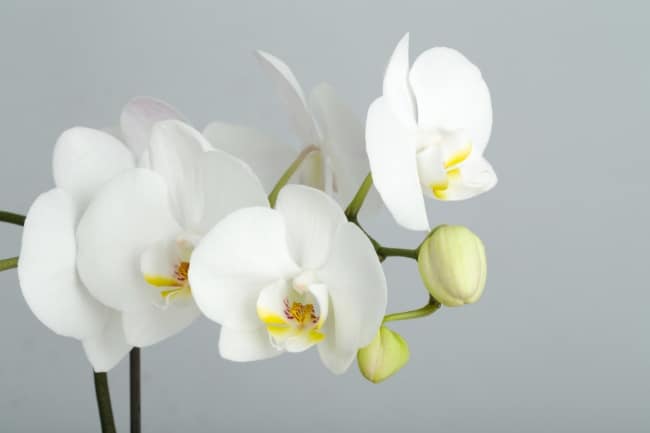The most common type of orchid is the phalaenopsis orchid, which typically blooms for two to four months. The flowering time will depend on the condition of the plant and how well it is cared for. Orchids can rebloom 1-2 times per year and can live for many years, with some records of orchids living for over 100 years.
There are many other varieties of orchid, and the typical duration of blooming for the most popular varieties are listed below.
- Cattleya Orchids – 7-21 days
- Oncidium Orchids – 4-6 weeks
- Paphiopedilum – 6-8 weeks
- Phalaenopsis – 8-16 weeks
- Dendrobium – 6-12 weeks
Making Your Orchids Bloom For Longer
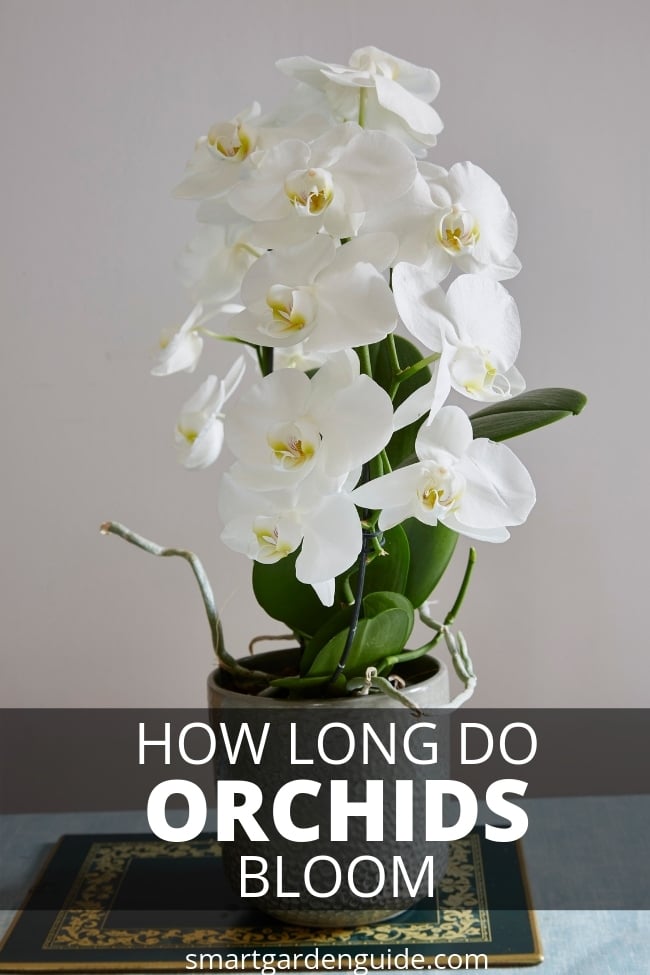
When people ask me how long do orchids bloom, I usually give the answer above. However, there are a number of things that you can do to ensure that your orchids bloom for as long as possible. Follow this simple advice, and you will get the best out of your orchids and enjoy the blooms for as long as possible.
Make Sure To Pick A Good Orchid At The Store
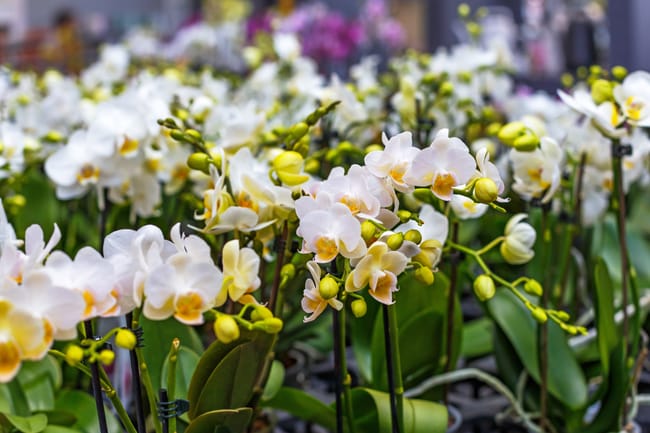
When buying an orchid, it’s very tempting to pick the orchid which has the most spectacular flowers, but this will usually mean that it is closer to the end of it’s flowering phase than the beginning.
You may find that your orchid blooms for only a few short weeks, before the flowers start to die and fall off the plant.
It is much better to pick an orchid with a strong, healthy flower spike, with some unopened buds and evidence that the flower spike itself is still growing and producing new buds.
If you do this, you can ensure that you will get weeks, or even months of new flowers to enjoy.
Temperature Control Can Help Your Orchids Bloom Longer
It is generally better to keep your orchids a little cool, as this stimulates the flowering process, and also slows growth and prolongs the flowering time of your orchid.
When purchasing your orchid and transporting it home, try to avoid causing your orchid stress by exposing it to excessively hot or cold conditions. It may be a good idea to make the purchase of an orchid the last thing on your shopping list, so that you can transport it home fairly quickly, to get it into ideal conditions.
At home, a temperature of 64°F to 77°F (18°C to 25°C) is usually adequate for most common varieties of orchids.
Avoiding sudden changes in the temperature of your home will also promote longer blooming time by reducing the stress on your plant.
Placement Of Orchids In Your Home
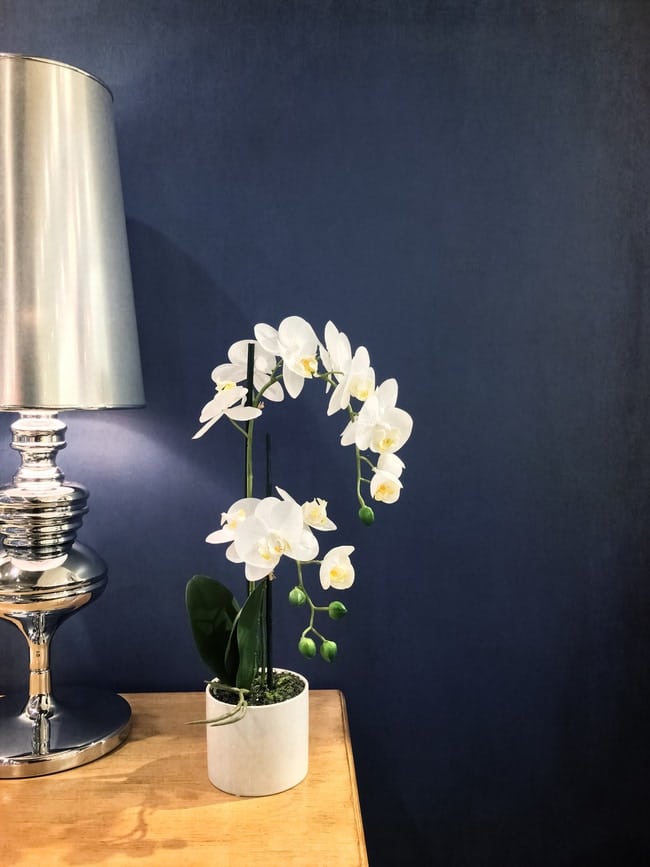
Keep temperature and lighting in mind when placing orchids in your home.
You should try to avoid putting your orchid anywhere that it will be exposed to hot or cold drafts.
If your orchid is frequently exposed to cold drafts, it can lead to stress and damage to the developing buds, which can cause a shorter blooming time, or even failure of some of the developing buds.
Frequent exposure to warm drafts, or hot dry air can lead to drying of the flowers, wilting and reduced bloom time due to the excessive stress to the flowers. For more information and tips about placing orchids in your home, see this article.
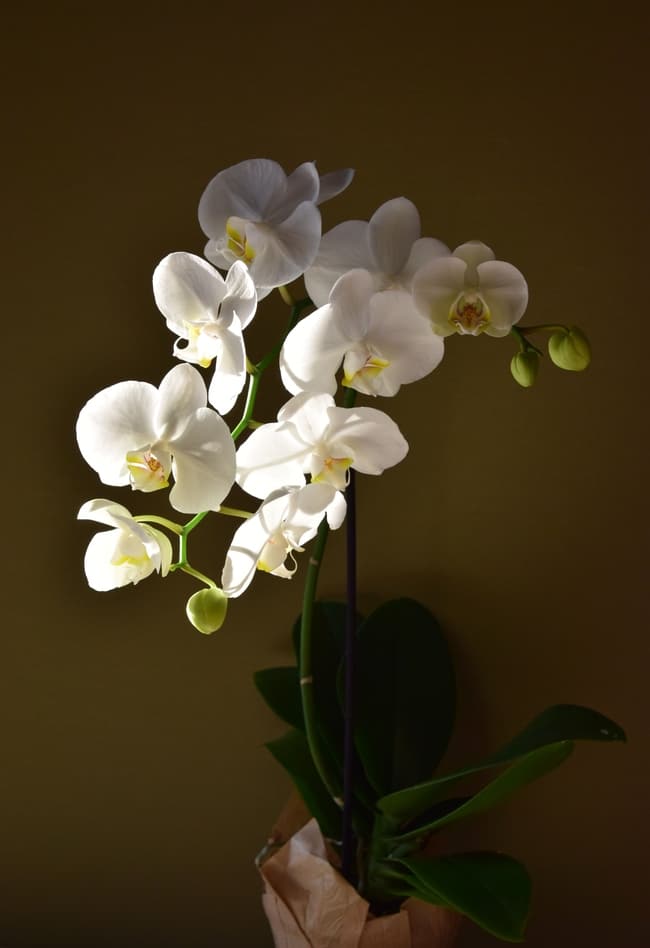
Appropriate Light Exposure Can Help Your Orchids Bloom Longer And More Often
Orchids thrive in indirect, but bright light, and placing your orchid in appropriate lighting conditions will increase the blooming duration of orchids. Too little light results in decreased photosynthesis, which can impair the ability to generate energy to maintain the current blooms and develop the next flower spike and flowers.
Excessive, direct sunlight can cause excessive drying and even scorching of the flowers and leaves. See more information here. This can not only lead to rapid loss of the existing flowers, but even death of the entire orchid.
Correct Watering Can Help Your Orchids Bloom For Months
Orchids can be quite sensitive to the amount you water them, and this can greatly impact the health of the plant, and in turn the length of bloom time. Orchids should always be potted in a really well draining medium, in a pot with a lot of drainage holes.
Orchids really suffer when they are left to sit in water or are watered excessively, as this can lead to suffocation and death of the roots.
The best thing to do is to monitor the dryness of the potting media, waiting until it is almost completely dry, before watering.
You should soak the roots with water thoroughly, taking care not to get the leaves and flowers wet. If you do this, the orchid will receive sufficient water, which will allow the flowers to concentrate on blooming, providing you with a beautiful display in your home.
Avoid Pollinating Insects
Once an orchid has been pollinated, it has fulfilled its biological purpose, and the flowers will often die quickly after pollination. As a result, it is a good idea to keep pollinating insects out of your orchid growing area.
Humidity
Humidity is an important factor in keeping orchid blooms healthy and long lasting. Orchid blooms can wilt, experience excessive stress and drop early when exposed to very dry conditions. Most homes will have humidity levels of above 40% and this is usually sufficient for most common orchid varieties.
For those homes that are unable to achieve sufficient humidity, you can increase the humidity by a number of methods. A humidifier can increase the humidity of a room generally, or a simple humidity tray can be placed under the orchid pot, which will normally raise the humidity levels to a satisfactory level.
Keep Your Orchids Away From Fruit And Air Fresheners
Ethylene gas, which is released by ripening fruit and some air fresheners can negatively impact the health of your orchid blooms, causing them to wilt and die prematurely. For this reason, you should not place your orchid in direct proximity to ripening fruit or air fresheners.
Don’t Mist Your Orchids To Prevent Damage To Their Blooms
Orchids thrive in humid conditions, but if the flowers are regularly sprayed with water, this can increase the risk of fungal disease on the orchid blooms, resulting in discolored spots on the flowers, or premature dropping of the flowers.
People sometimes question this advice, as orchids, particularly the common varieties grown at home, are plants which originated in the rainforest. Rainforests are notorious for frequent rainfall and humid conditions, and you would imagine that this would also predispose the orchids to fungal disease. However, most indoor spaces have very little moving airflow, and it is the combination of the wet flowers and lack of airflow, which makes orchids grown in indoor spaces much more at risk of developing fungal disease.
Orchid Blooming Duration Depends On The Type Of Orchid
Whilst these orchid blooming tips provide a general guide, there are differences between the common varieties of orchid, and I would recommend that you look for information specific to your orchid variety in addition to this guide. The most commonly purchased variety of orchid is the phalaenopsis orchid, and I have a comprehensive guide to caring for these wonderful orchids here.
Allow Your Orchids To Rebloom
There is another way to answer the question of how long do orchids bloom. Orchids can bloom for several months at a time, once or twice a year for many many years.
Orchids can be long lived plants and will bloom repeatedly for many years if grown in the right conditions.
It always saddens me that so many people assume that once an orchid has finished blooming, it is dead, and they either neglect it or throw it away.
It’s really surprisingly easy to take care of an orchid in the vegetative state, and after a few months, you are likely to see a new flower spike and you won’t have to wait long before your orchid is flowering again.

